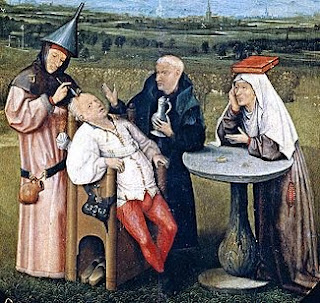Film Review
I have to make a confession. I have a soft posterior fontanelle. When I press on that spot, my head indents noticeably — enough that you can actually see it. Furthermore, I frequently feel a sort of need to do this. And when I do it, it seems to help me feel less sleepyheaded and more focussed. If I'm feeling a bit woozy, it helps me feel less so. And, indeed, sometimes I feel as though I'd like to drill right into it — as though there is some sort of psychic G spot hungering to be stimulated and satisfied. Naturally, I've been intrigued by trepanning — the practice of intentionally drilling small holes in the skull.
Of course, trepanners don't necessarily aim for the fontanelle, although the spot is name-checked in A Hole in the Head, this wonderfully amusing award-winning 55 minute documentary on the topic. Indeed, since many of the contemporary enthusiasts for the practice do this DIY... while looking at themselves in the mirror (sort of like shaving!) — the front of the head seems to be favored.
In fact, a couple of minutes into A Hole in the Head, we are confronted with a clip from a 1970 film — Heartbeat in the Brain — that was made showing Amanda Feilding's self-trepanation. Feilding — the attractive English doyenne of contemporary trepanning and a leading figure in British '70s psychedelia — freshly trepanned, stares into a mirror, her face patched and speckled with blood, looking as happy and satisfied as Sooky Stackhouse after a long night with Bill Compton and Eric Northman. As she wipes blood from her teeth, there's the faint hint of a smile.
Fans of grisly medical shows will definitely find satisfaction in this film. The most disturbing scene, which is also toward the beginning of the film and runs for several minutes, shows an African woman's fully exposed brain matter being drilled by a witch doctor.
But shock is not the point here — or at least it's not the entire point. The film is also informative. Toward the beginning, A Hole in the Head examines the history of trepanning — including the archeological evidence for the existence of the practice in various "primitive" cultures, as well as at various points in European culture where it was variously used as a "cure" for physiological problems and for "letting the demons out" for patients suffering from mental problems.
The film primarily focuses on the contemporary trend for self-trepanation, which seems to be centered largely in Great Britain among psychedelic types. There is even a quote from Paul McCartney from a 1986 interview in Musician in which he talks about how John Lennon seriously considered fixing (to get) a hole in his head and asked McCartney to join him. The ever wily McCartney replied: "You go first" (or words to that effect.)
The operant theory here is that the process increases "blood brain volume," leaving the trepanned person smarter, happier and a little bit high... permanently. Testimonies from the people with the holes in their head are balanced out by interviews with skeptical neuroscientists, who pretty much all agree that the claims made by the advocates are absurd. (One younger neuroscientist believes that it's vaguely possible that their could be some slight enhancement from increased blood flow, but that it needs to be tested, scientifically.) The believers sound happy; the skeptics sound amused (and sane), and many who watch this documentary will likely be all of the above.
As for myself, despite my soft fontanelle, I will put my faith, for now, in the neuroscientists and not take a drill to my skull.
R.U. Sirius @'h+'










No comments:
Post a Comment